How a New Generation of Hoteliers and Chefs Is Creating a More Inclusive Martha's Vineyard
The Massachusetts island is more than just the preppie paradise of yesterday. Here's how to explore the newer, more diverse Martha's Vineyard.

Elizabeth Cecil
Menemsha Harbor at sunset.It was close to sunset, and our boat had just pulled in to Menemsha Harbor. Menemsha is a fishing village on the tail end of Martha’s Vineyard, in the literal sense. If you look at the Massachusetts island on a map, it resembles a fish. The popular towns of Oak Bluffs and Edgartown are positioned on the top and bottom of its mouth, and are connected, fittingly, by “Jaws Bridge” — nicknamed after the 1975 blockbuster, which was filmed in the area.
What kind of fish the island looks like, besides an expensive one, I couldn’t tell you. I’m not originally from there, unlike most of the people who dwell in Menemsha. Many residents’ families have lived in this tiny community of gray shingled homes for generations. During the day, you can find teenagers working summer jobs at Menemsha Fish Market or its neighbor, Larsen’s, gutting sea bass while cracking jokes with their friends — their noses seemingly immune to the stench of innards.
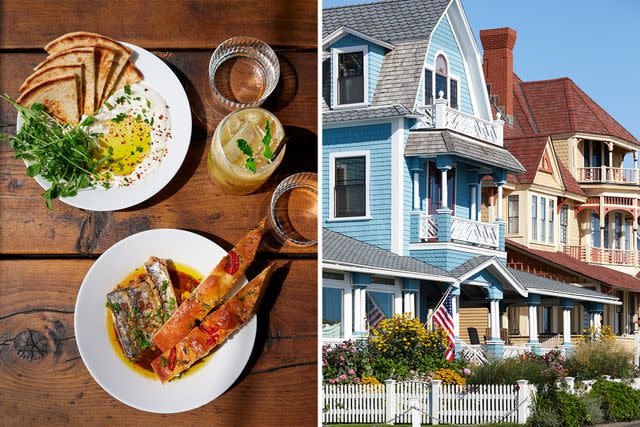
Elizabeth Cecil
From left: Labneh with pea shoots, Moroccan sardines, and lavender lemonade at Aalia's; Victorian gingerbread houses in Oak Bluffs.I didn’t mind the smell, either. I felt a sense of comfort being around other working people. Martha’s Vineyard is known as a resort for the wealthy, and when I arrived on its shores last July, I feared I would be floating without a life raft amid the choppy waters of privilege. I never had the money — either growing up or as an adult — to “summer” anywhere, let alone in a place like this.
"I became so intoxicated by the sea, the smell of salt, the gentle breeze in my hair"
But there I was, still dry. I was safely aboard the Island Girl, steered by the able Captain Eamonn Solway. I can’t swim, I told him about a hundred times. He smiled like the reassuring dad he is. (The boat was christened with his daughter’s nickname.) We stopped in Menemsha Harbor after sailing along the north side of the island, between Martha’s Vineyard and Naushon Island. The latter is owned by the Forbes family, Captain Solway told me and my friend Sarah, knowing we were both journalists. (He also pointed out Diane Sawyer’s house, a gorgeous compound called Chip Chop that sold last fall for almost $24 million.) I became so intoxicated by the sea, the smell of salt, the gentle breeze in my hair, and my exciting new plan to become a TV anchor, that I almost forgot about my fear of the water.
But then, I heard a sound. Duunnn dunnn. It went away, and then came back. Duunnn dunnn.
“Is that the Jaws theme?” I asked Captain Solway.
“Yeah, it’s my ringtone,” he replied.
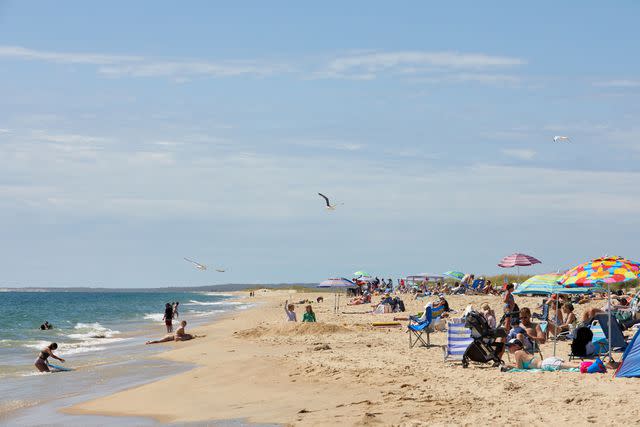
Elizabeth Cecil
South Beach, in Edgartown.You would think that the people of Martha’s Vineyard would play down the Jaws connection. But the great white’s gaping maw is everywhere you look. While I was visiting the island, Mad Martha’s ice cream shop, in Edgartown, was advertising its flavor of the week in the window: Shark Attack (vanilla ice cream colored blue with raspberry swirl and white chocolate). At the Martha’s Vineyard Museum, there was an exhibit on the making of Jaws, with photographs of locals signing up to be extras in the movie. When I met Guinevere “Guin” Cramer of the local chamber of commerce for coffee, she told me that everyone was preparing for the film’s 50th anniversary in 2025, an occasion that will attract fans from all over the world. “We’re going to need a bigger island!” she shouted with glee.
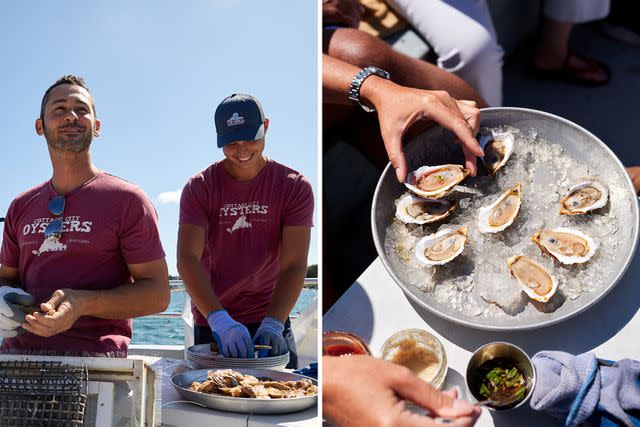
Elizabeth Cecil
From left: Brothers Dan, left, and Greg Martino of Cottage City Oysters on their hour-long tour of Vineyard Sound; freshly shucked bivalves aboard the Leeward, Cottage City Oysters' tour boat.The irony is that in the film, the mayor of Amity Island (the fictional name for Martha’s Vineyard) thinks news that a shark is on the loose will scare off tourists — and their dollars. Indeed, the villain of the original film is not just the shark but greed, and a culture that puts profits over people. This theme felt relevant to my trip. Before my departure, I started making a list of the beaches I wanted to visit. It was love at first sight when I came across images of Lucy Vincent, a postcard-pretty stretch of sand barely trampled by human feet.
Related: 20 Best Weekend Getaways in New England
I quickly realized that’s because it’s a private beach; in fact, only a third of the island’s shoreline is open to the public. I worried this might be a harbinger of the moneyed culture I would find. However, as Cramer and I talked, I learned about a new generation of small-business owners and chefs — young, diverse, and progressive — who are remaking Martha’s Vineyard, trading in deck shoes for a rising tide that lifts all boats.
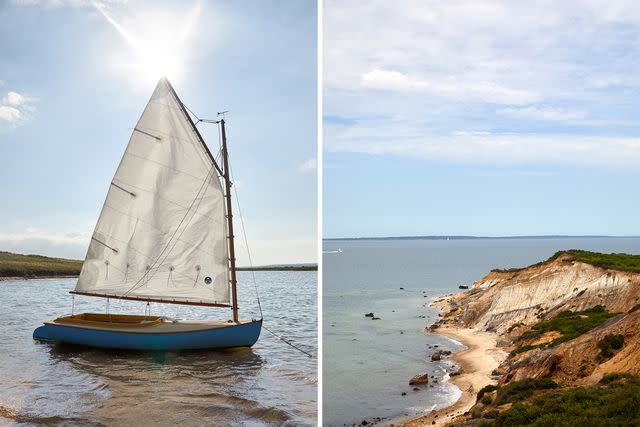
Elizabeth Cecil
From left: Ready to sail on Tisbury Great Pond; the Atlantic Ocean, as seen from the top of the Aquinnah Cliffs.The morning after I arrived, I woke up and took in the view from my suite at Faraway Martha’s Vineyard, a luxury hotel in Edgartown that’s injected a bit of Hollywood glamour amid the reserved, stealth-wealth inns the island is better known for. In the foreground was the pool, surrounded by white cabanas. In the background was the deep blue of Edgartown Harbor, dotted with yachts like clouds. To my left, I could see historic Water Street, where whaling captains built their homes in the early 19th century. Like many parts of coastal New England, Martha’s Vineyard grew out of the whaling industry: the island became known for making candles from whale oil, producing a smokeless variation favored by wealthy Americans. Today, Edgartown still looks like money, with BMWs crowding narrow streets lined with high-end boutiques.
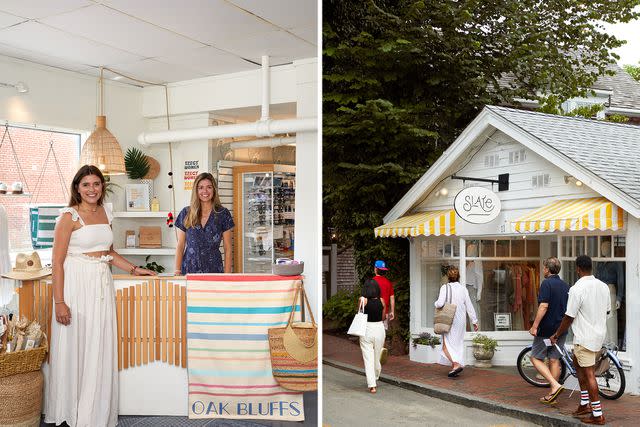
Elizabeth Cecil
From left: Sofie Green, left, and Ashley Rohlfing at their Oak Bluffs shop, Island Outfitters; Slate, a clothing store in Edgartown.Because I am relatively young and African-American, I felt obliged to first visit Oak Bluffs, the Vineyard’s more relaxed and multicultural seaside town. In 1912, Shearer Cottage — the first Black-owned guesthouse for African-American tourists of its kind — opened on Rose Avenue, paving the way for Oak Bluffs to become a popular summer destination for the Black bourgeoisie. Inkwell Beach became a haven for Black travelers from across the U.S., at a time when most of the country’s public pools and boardwalks were segregated.
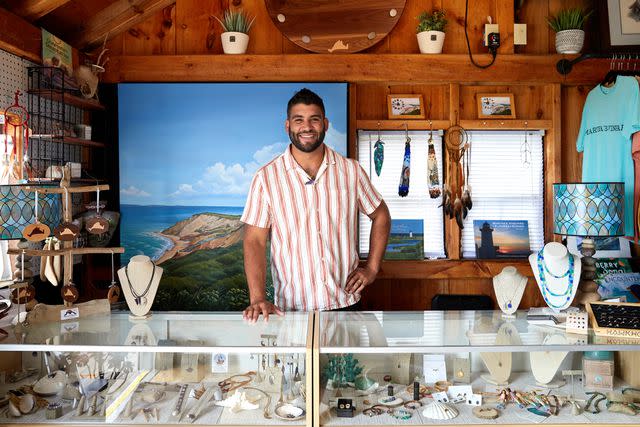
Elizabeth Cecil
Del Araujo at Aquila, a coffee shop in Aquinnah Cliffs that also sells work by Indigenous artists.Oak Bluffs is also the most family-friendly of the towns on Martha’s Vineyard — lots of pizza parlors, souvenir shops, and “must-sees” like the Flying Horses Carousel, the oldest in the country, and the brightly painted gingerbread cottages. I skipped both. Instead, like a good millennial, I was eager to have a salad I had seen on Instagram: the Menemsha Cobb at MV Salads, the “Menemsha” part being the generous helping of lobster on top of the other, suddenly irrelevant-to-me ingredients. Owner Susanna Herlitz-Ferguson told me she buys the lobster from a seafood market in Vineyard Haven and the corn and tomatoes from a farm in Edgartown.
“Everything we can get here, we get here,” she said. Herlitz-Ferguson is part of a movement on Martha’s Vineyard to source products as locally as possible and to support the island’s farmworkers. She is particularly proud to have started her business later in life. When she first opened MV Salads, she told me, she was often met with confusion. Her friends wondered why she would start something new just as everyone else was retiring. But it was clear from our conversation that Herlitz-Ferguson had more energy than I did.
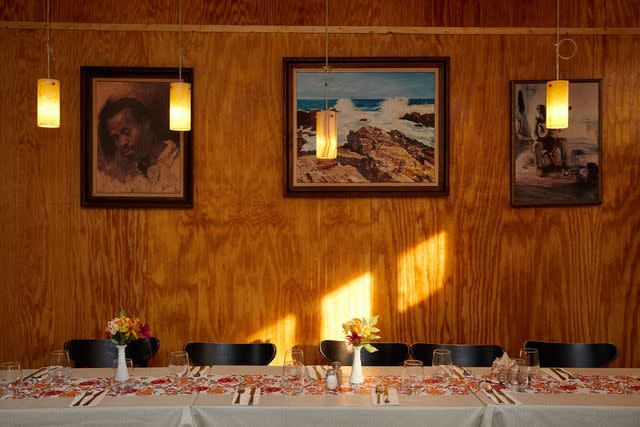
Elizabeth Cecil
Chef Deon's Kitchen, inside the VFW Hall in Oak Bluffs.I had been told that Kennebec Avenue was “the Brooklyn of Oak Bluffs.” I chuckled at first, but when I got there, I thought, There’s something to this. The street is a quiet, laid-back enclave that feels separate from the town’s summer tourist swarm. I stopped at Aalia’s, a coffee shop by day, a Lebanese fusion restaurant by night. I ordered a mocha infused with cardamom and chatted a bit with the manager, Addy, who told me he used to live in Brooklyn. (Aha!) He suggested I come back for dinner. I didn’t want to visit the same place twice, but when I looked at the menu — Moroccan sardines, North African chicken, labneh with pea shoots — I made a reservation.
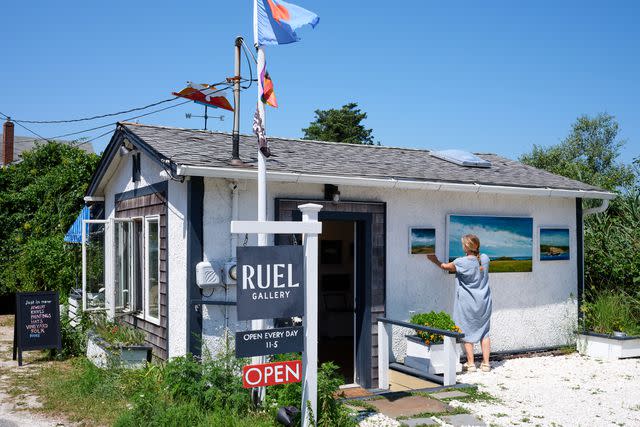
Elizabeth Cecil
Jewelry maker Nettie Kent outside Ruel Gallery, in Chilmark, which she owns with her husband, painter Colin Ruel.At Island Outfitters, a shop for casual clothing and beach gear, I met owner Sofie Green, whose name was on everyone’s lips in “O.B.,” as locals call it. Green wore white Birkenstocks (the shoe of last summer, thanks to Barbie) and greeted customers with her cheerful Alabama accent. She has helped organize the Martha’s Vineyard Pride Parade since its debut in 2022. “The queer community here is small but close-knit,” she explained as she straightened the sunglasses display, never not working. I asked her if there was a gay bar on the island and she offered a characteristically optimistic “not yet.” She added, “The closest thing is probably the Ritz.”
More Trip Ideas: 19 Best Things to Do on Cape Cod — From Whale Watching to Wine Tasting
So, after dinner at Aalia’s, I headed to the Ritz, a popular local dive bar, to check out the vibe. It was a bit of a record-scratch moment, walking in after a day of such luxury. The Ritz is not a gay bar, but it’s gay-affirming (rainbow décor abounds), and boasts a refreshing honesty about what brings a lot of people to Martha’s Vineyard. I mean that I could purchase a “Rich Bee-yotch” shot. While Sarah went to order us a couple, a woman leaned in and asked me in a thick Massachusetts accent: “Is that your paht-nah?”
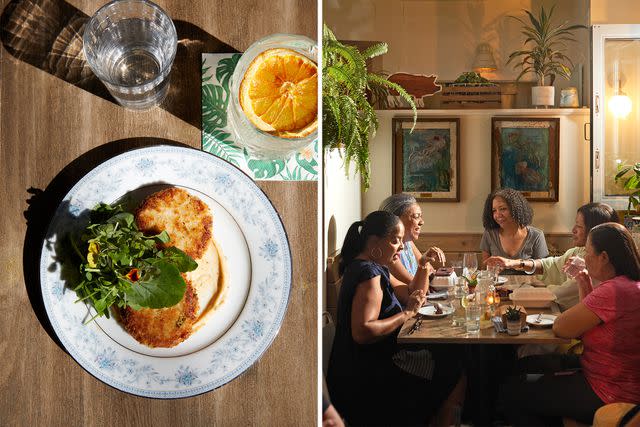
Elizabeth Cecil
From left: Vegan crab cakes topped with lemon-caper aioli and watercress and served with a craft cocktail at Pawnee House, in Oak Bluffs; dining at the Pawnee House.The next morning, I walked through the lobby of Faraway, enjoying the blend of rosemary, lavender, and mahogany being pumped through the vents. (“Old ship meets the sea” is how it was explained to me.) I made my way past the expensive sweaters at the Shop by Wheat, the hotel’s boutique and café, to buy a croissant, which I ate so quickly that the flakes went all over my cheap sweater. I was in a hurry to meet brothers Dan and Greg Martino, the owners of Cottage City Oysters, who were taking me out on their boat.
Related: T+L's Review of Faraway Martha's Vineyard
The Texas-born Martinos are movie-star handsome but sound like marine biologists as they describe the unique “merroir” (the aquatic variation of terroir) of Oak Bluff oysters, or explain how an oyster’s shell absorbs excess carbon. The siblings work closely with the Woods Hole Oceanographic Institution to study how oyster farms can serve as reefs for the surrounding habitat. They are also fans of eating locally — so locally, in fact, that their oysters can be found only on Martha’s Vineyard. “This oyster doesn’t travel,” they brag. They service chefs aboard private yachts, select restaurants in Martha’s Vineyard, and even catered Barack Obama’s 60th birthday party. Once we reached their oyster farm, the brothers started shucking bivalves for me. “This is the freshest oyster you’ll ever eat,” Dan said, passing me one flavored only by salt water and sunshine.

Elizabeth Cecil
Captain Eamonn Solway steers his boat, Island Girl, around the Aquinnah Cliffs.Sarah and I decided to spend the afternoon at South Beach, located near downtown Edgartown and surrounded by farms and an old airfield. I went into the water a few times with my signature tentativeness before returning to my comfort zone: reading Moby-Dick on a towel. On our way back to Edgartown, the young Russian driver of our Uber, a blindingly white Tesla, told us he had come to Martha’s Vineyard the previous summer in search of work. (There are many migrant workers on the island.) I studied Russian in college, so I conversed with him in his native language. “Have you seen Obama?” I asked. He had, and not just anywhere. He had been working as a busboy at Garde East, a restaurant in West Tisbury, when Obama came in with a large party and shook the hand of everyone on staff, including him. “It was my first time in America, and I met the president! I couldn’t believe it!” he told me, beaming.
"In the distance I could see the Aquinnah Cliffs, one of the island’s most popular tourist attractions — and yet there was hardly a soul at the lookout point. We took photos with the pink clay cliffs in the background, our view encumbered by nothing and no one. "
I knew I would be eating a lot of seafood on Martha’s Vineyard, but I was keen to see it prepared in ways that went beyond the usual American method of slathering it in butter and sticking it on a bun (not knocking that, though). Chef Deon’s Kitchen, a Caribbean restaurant, is on a residential street a bit away from the main action of Oak Bluffs, so I might have missed it if I hadn’t seen a handwritten poster announcing the evening’s specials: ram goat curry, honey-bourbon turkey wings, lobster mac and cheese.
Deon’s is located inside the town’s Veterans of Foreign Wars building. The walls are painted orange, and the circular tables are designed for large parties. It reminded me of the basement of my grandmother’s Baptist church in West Philadelphia, and I told chef Deon Thomas, who came to the U.S. from Jamaica to study at the Culinary Institute of America, that the food was just as good. “To say it’s as good as your grandmother’s cooking is the greatest compliment,” he replied, smiling.
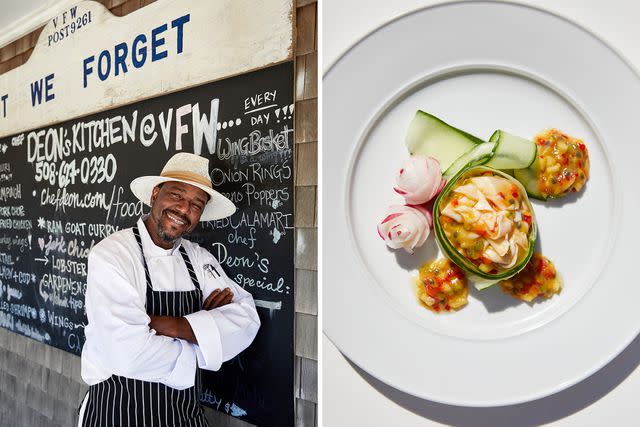
Elizabeth Cecil
From left: Chef Deon Thomas at his Oak Bluffs restaurant, Deon's Kitchen; chef Thomas's specialty dish, "the empress and the conch."I started off with conch chowder, then a local fluke cooked in paper. That was already a lot of food, but I had to try his famous jerk chicken. Chef Deon treats every dish as a delicacy, with the kind of attention to detail and fine balance of flavors that belies the humble setting. It was probably the most sophisticated meal I had while on Martha’s Vineyard, one I happily washed down with a Red Stripe.
I was sad to leave Faraway, but I needn’t have despaired. Our next hotel, the Hob Knob, was a 10-minute walk away, but it might as well have been another world — a quaint and homey cottage, in the Gothic Revival style the Vineyard is known for, in contrast to the high-concept cosmopolitan luxury of the Faraway. The lobby of the Hob Knob smelled of cookies, which are freshly baked there every afternoon. What simple pleasures I found myself enjoying at this inn that runs several hundred dollars a night!
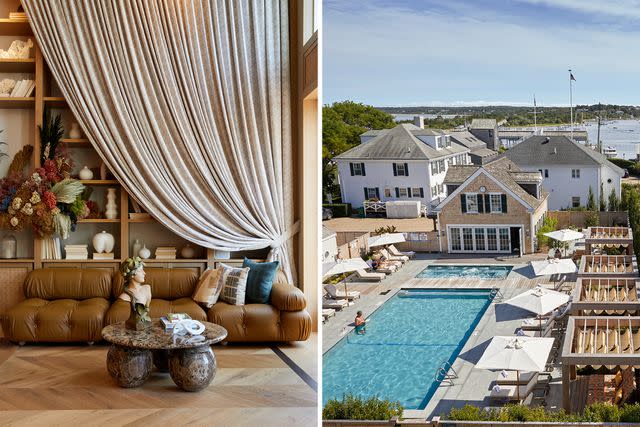
Elizabeth Cecil
From left: The lobby of Faraway Martha's Vineyard, a hotel in Edgartown, Massachusetts; the pool at Faraway, with Edgartown Harbor beyond.The next day was the one I had waited for all week: Down-Island day, when we would visit Aquinnah and Chilmark, towns on the tail-shaped side of Martha’s Vineyard. Guin Cramer suggested that Sarah and I rent a Jeep so that we could feel the wind on our faces. She drove us deeper into Aquinnah, a town that announced itself only by its quietude. I had been wondering all week why people talked about “Down-Island” as though it were the far side of the moon, when it was only a 30-minute drive away. But now, the wind blowing through the parts of my hair not covered by my pink Mad Martha’s baseball cap, I got it. Aquinnah has a serene natural beauty that feels worlds away from the manicured lawns of Edgartown and the frenzied fun of Oak Bluffs. In the distance I could see the Aquinnah Cliffs, one of the island’s most popular tourist attractions — and yet there was hardly a soul at the lookout point. We took photos with the pink clay cliffs in the background, our view encumbered by nothing and no one.
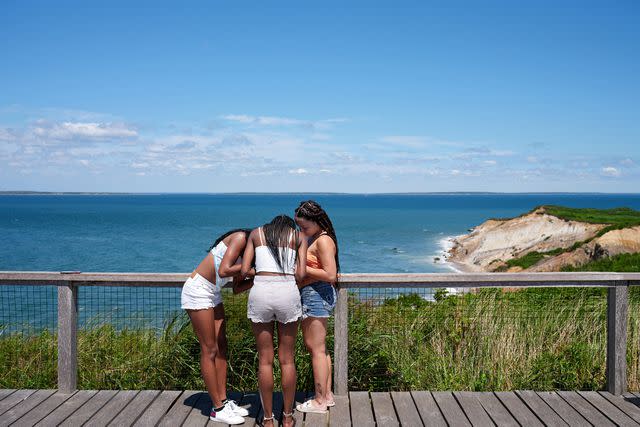
Elizabeth Cecil
Pausing by the Atlantic at the Aquinnah Cliffs.Before we headed back to the car, we stopped for coffee at Aquila, a café and boutique co-owned by Del Araujo, a member of the Wampanoag Tribe of Gay Head (Aquinnah). Like Sofie Green, Araujo — a tall, affable millennial with a smile as warm as the sun — is a local celebrity, known for blending business acumen with a commitment to inclusion. The coffee at Aquila is tasty, but the real draw of this place is the Native-made jewelry and artworks. There are dream catchers, hand-stitched baby booties, and jewelry made of wampum, the white and purple shell beads the Wampanoags once used as currency. Most pieces are made by local artists, but Araujo also sells work by Sioux and New York–based artisans he has met on the pow-wow circuit. Araujo is committed to making Martha’s Vineyard a destination for Native American art, and he often turns the patio of his café into a place to hold pop-up exhibits.
"What a tiny place to never leave, what a specific corner of the universe to commit to for generations, and what a gloriously stubborn refusal to cede this place to affluent newcomers. "
Cramer drove us to Menemsha for a quick stop. Sarah wanted to try the soft serve from Menemsha Galley, a local institution. While she was in line, I checked out Ruel Gallery, a tiny white structure on the side of the road. Fittingly, the first thing I saw was a painting by owner Colin Ruel of an ice cream cone covered in rainbow sprinkles. After looking over a glass case that contained oyster-shucking knives Ruel makes by hand, I spoke with his wife and co-owner Nettie Kent, a jewelry maker. She explained that the space used to be the garage where Ruel’s great-grandfather kept his Model A Ford. “He’s seventh-generation Menemsha,” she added. I marveled at that. What a tiny place to never leave, what a specific corner of the universe to commit to for generations, and what a gloriously stubborn refusal to cede this place to affluent newcomers.
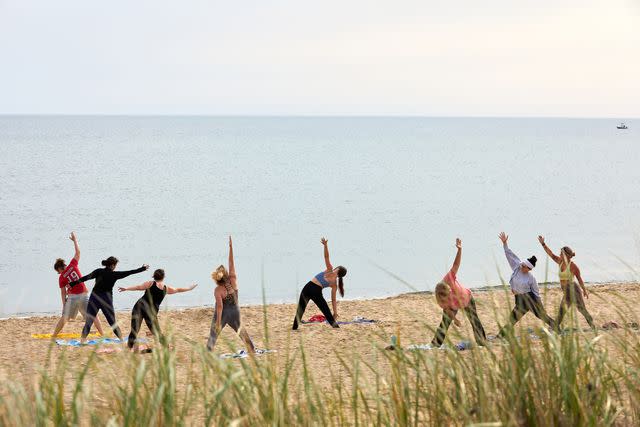
Elizabeth Cecil
Yoga on the Vine's morning class on Bend in the Road Beach, in Edgartown.I said goodbye and went to find Sarah. As I walked I took in the sight of Menemsha for what I thought was my last time. But was it? I had envisioned this trip as an exotic safari to observe the waterways of wealth, the flora and fauna of a Lilly Pulitzer dress. But after meeting Del Araujo, Sofie Green, Chef Deon, and so many others determined to make Martha’s Vineyard a boat big enough to fit us all, I wondered if this was just goodbye for now. The island had sunk its teeth into me, and still hasn’t let go.

Elizabeth Cecil
A studio suite at Faraway.Where to Stay
Faraway Martha’s Vineyard
A stem-to-stern makeover has brought the former Kelley House, an Edgartown inn that dates back to 1742, squarely into the 21st century, with 58 rooms and suites that feel fresh and contemporary. Also on hand: a boutique and saltwater pool with an adjoining bar. Try the signature clam chowder at the Newes from America restaurant, as well as locally caught sushi at the Pelican Club.
Hob Knob
This classic New England inn in a 19th-century house in Edgartown has been accommodating guests for a century (including, in the 1940s, the Kennedy family). Its 17 guest rooms are simply decorated and filled with antiques.
Where to Eat and Drink
Aalia’s
Stop by this popular Oak Bluffs newcomer for an egg sandwich on a croissant in the morning, then return for lamb moussaka and spicy shrimp — plus live music — in the evening.
Bettini
Treat yourself to sweeping views of Edgartown Harbor over eggs Benedict or house-made pasta at this sophisticated restaurant at the Harbor View Hotel.
Chef Deon’s Kitchen
Deon Thomas bills himself as the “three-island chef,” bringing the flavors of his native Jamaica as well as Anguilla, where he once lived and worked, to Martha’s Vineyard.
Garde East
An upscale restaurant with a menu of seafood classics and a wine list of more than 500 bottles. Try to grab a table on the deck overlooking the Vineyard Haven Marina.
Mad Martha’s
Line up for flavors like black raspberry and mud pie at Martha’s scoop shops in Edgartown, Oak Bluffs, and Vineyard Haven.
MV Salads
Fresh, colorful salads in Oak Bluffs, with ingredients grown on the island. Make your own or choose from a menu of signature combinations.
Orange Peel Bakery
At her Aquinnah establishment, Native owner Julianne Vanderhoop makes breads and sweet and savory treats in her wood-fired stone oven — and offers pizza on weekend evenings in the summer.
Pawnee House
Having dinner at this chic but down-to-earth Oak Bluffs eatery feels like being invited over for a meal by your coolest friends.
The Ritz
An inclusive dive bar and music joint in Oak Bluffs.
Rosewater Market
Try to fit all of Martha’s Vineyard into your mouth at once at this great Edgartown takeout spot, which makes salads and sandwiches using ingredients from more than a dozen local farms. The coffee beans are roasted on the island by Chilmark.?
What to Do
Cottage City Oysters
Brothers Dan and Greg Martino offer tours of their open-ocean oyster farm near Oak Bluffs on their 31-foot boat and explain how oysters grow. Dan is also the author of "The Oyster Book," a global history of oyster farming set to be published this fall.
Island Girl Excursions
Book a half- or full-day charter with Captain Eamonn Solway, who steers his boat, Island Girl, from the town of Vineyard Haven to islands and coves in Vineyard Sound and beyond.
Martha’s Vineyard Museum
Now celebrating its 101st anniversary, this sequence of bright, airy galleries in Vineyard Haven holds a permanent exhibition on the history of the island, as well as temporary exhibitions on its cultural life.
Wheel Happy Bicycle Shop
Rent a bike for the day or week at this full-service Edgartown shop for a spin to one of the nearby beaches or towns.
Yoga on the Vine
Start the day fresh with a morning yoga session on State Beach in Oak Bluffs, then cool down with a swim.
Where to Shop
Aquila
A beguiling coffee shop perched on the Aquinnah cliffs that sells crafts by Indigenous artists.
Island Outfitters
Find classic New England beach outfits at this Oak Bluffs boutique.
Ruel Gallery
Evocative maritime paintings by Colin Ruel and jewelry by his wife, Nettie Kent, are on display at this Menemsha boutique.
Salte
An airy, inviting boutique that brings a global seaside aesthetic to Edgartown, with pillows, textiles, and totes inspired by places like Tulum and the beaches of Morocco.
A version of this story first appeared in the May 2024 issue of Travel + Leisure under the headline "Little Island, Big Heart."
For more Travel & Leisure news, make sure to sign up for our newsletter!
Read the original article on Travel & Leisure.